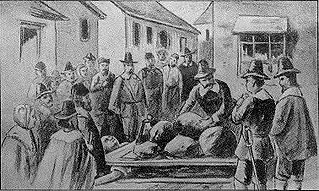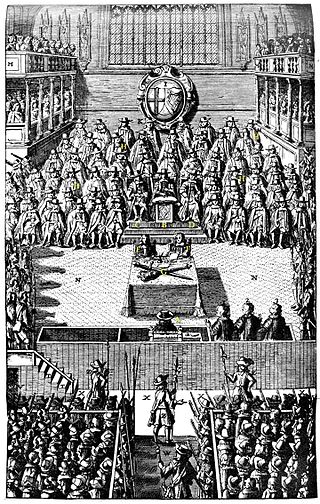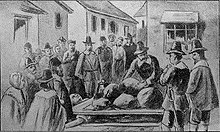
Arraignment is a formal reading of a criminal charging document in the presence of the defendant, to inform them of the criminal charges against them. In response to arraignment, in some jurisdictions, the accused is expected to enter a plea; in other jurisdictions, no plea is required. Acceptable pleas vary among jurisdictions, but they generally include guilty, not guilty, and the peremptory pleas setting out reasons why a trial cannot proceed. Pleas of nolo contendere and the Alford plea are allowed in some circumstances.
In United States law, an Alford plea, also called a Kennedy plea in West Virginia, an Alford guilty plea, and the Alford doctrine, is a guilty plea in criminal court, whereby a defendant in a criminal case does not admit to the criminal act and asserts innocence, but accepts imposition of a sentence. This plea is allowed even if the evidence to be presented by the prosecution would be likely to persuade a judge or jury to find the defendant guilty beyond a reasonable doubt. This can be caused by circumstantial evidence and testimony favoring the prosecution, and difficulty finding evidence and witnesses that would aid the defense.
Nolo contendere is a type of legal plea used in some jurisdictions in the United States. It is also referred to as a plea of no contest or no defense. It is a plea where the defendant neither admits nor disputes a charge, serving as an alternative to a pleading of guilty or not guilty. A no-contest plea, while not technically a guilty plea, typically has the same immediate effect as a guilty plea and is often offered as a part of a plea bargain.
A plea bargain is an agreement in criminal law proceedings, whereby the prosecutor provides a concession to the defendant in exchange for a plea of guilt or nolo contendere. This may mean that the defendant will plead guilty to a less serious charge, or to one of the several charges, in return for the dismissal of other charges; or it may mean that the defendant will plead guilty to the original criminal charge in return for a more lenient sentence.
In law, a plea is a defendant's response to a criminal charge. A defendant may plead guilty or not guilty. Depending on jurisdiction, additional pleas may be available, including nolo contendere, no case to answer, or an Alford plea.
Death by crushing or pressing is a method of execution that has a history during which the techniques used varied greatly from place to place, generally involving placing heavy weights upon a person with the intent to kill.

Giles Corey was an English farmer, petty thief, and tried murderer who was accused of witchcraft along with his wife Martha Corey during the Salem witch trials. After being arrested, Corey refused to enter a guilty or not guilty plea. He was subjected to pressing in an effort to force him to plead and died after three days of this torture. Because Corey refused to enter a plea, his estate passed on to his sons instead of being seized by the local government.

The Statute of Westminster of 1275, also known as the Statute of Westminster I, codified the existing law in England, into 51 chapters. Chapter 5 is still in force in the United Kingdom and the Australian state of Victoria whilst part of Chapter 1 remains in force in New Zealand. It was repealed in Ireland in 1983.
In tort law, detinue is an action to recover for the wrongful taking of personal property. It is initiated by an individual who claims to have a greater right to their immediate possession than the current possessor. For an action in detinue to succeed, a claimant must first prove that he had better right to possession of the chattel than the defendant, and second, that the defendant refused to return the chattel once demanded by the claimant.

Henry of Bracton, also known as Henry de Bracton, Henricus Bracton, Henry Bratton, and Henry Bretton, was an English cleric and jurist.
North Carolina v. Alford, 400 U.S. 25 (1970), was a case in which the Supreme Court of the United States affirmed that there are no constitutional barriers in place to prevent a judge from accepting a guilty plea from a defendant who wants to plead guilty while still protesting his innocence under duress as a detainee status. This type of plea has become known as an Alford plea, differing slightly from the nolo contendere plea in which the defendant agrees to being sentenced for the crime, but does not admit guilt. Alford died in prison in 1975.

The High Court of Justice was the court established by the Rump Parliament to try Charles I, King of England, Scotland and Ireland. Even though this was an ad hoc tribunal that was specifically created for the purpose of trying the king, its name was eventually used by the government as a designation for subsequent courts.
A mute of malice is a defendant in a criminal case who willfully chooses not to speak, as opposed to one who does not speak because he is physically or psychologically unable to do so.

The Hale Commission was established by the Commonwealth of England on 30 January 1652 and led by Sir Matthew Hale to investigate law reform. Consisting of eight lawyers and thirteen laymen, the Commission met approximately three times a week and proposed changes as radical as reducing the use of the death penalty, allowing witnesses, legal aid and lawyers for defendants in criminal cases and creating county courts and a court of appeal for criminal cases. Though the Commission was unsuccessful at passing any of its measures under the Rump Parliament, two of its measures were put into law by the subsequent Barebone's Parliament, and, by the middle of the 20th century, most of the others were as well. Debate has occurred over the effectiveness and strife within the Commission between its more moderate and radical members; the general conclusion is that with the sheer volume of work produced and the vast proportion of moderate to radical members, it is unlikely such strife existed.
In modern U.S. usage, forfeiture is deprivation or destruction of a right in consequence of the non-performance of some obligation or condition. It can be accidental, and therefore is distinguished from waiver. In the law of England and Wales, the forfeiture rule is the rule of law which prevents a killer from inheriting the estate of a person they have unlawfully killed. The term also refers to the rule in English law under which an insured person who makes a fraudulent insurance claim loses their claim: this rule was derived from common law until the passage of the Insurance Act 2015, which "puts the common law rule of forfeiture on a statutory footing".
Brady v. United States, 397 U.S. 742 (1970), was a United States Supreme Court case in which the Court refused to hold that large sentencing discounts and threats of the death penalty are sufficient evidence of coercion.
William Spiggot was a highwayman who was captured by Jonathan Wild's men in 1721. During his trial at the Old Bailey, he at first refused to plead and was therefore sentenced to be pressed until he pleaded. This was called Peine forte et dure. He was later executed, after a second trial when he pleaded not guilty, on 11 February 1721 at Tyburn, London.

The Criminal Law Act 1827 was an act of the Parliament of the United Kingdom, applicable only to England and Wales. It abolished many obsolete procedural devices in English criminal law, particularly the benefit of clergy. It was repealed by the Criminal Law Act 1967.
Jane Wiseman was an English recusant and priest harbourer. She narrowly avoided becoming a Catholic martyr after being sentenced to Peine forte et dure. Her daughter Mary Wiseman was the founding prioress of a convent in Leuven.








